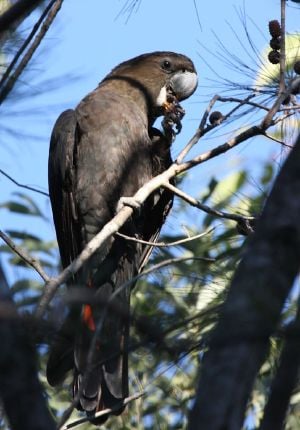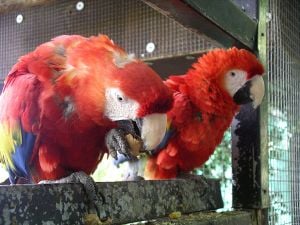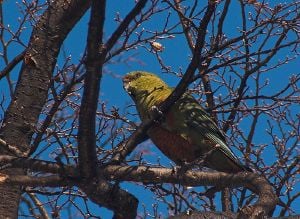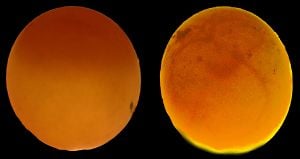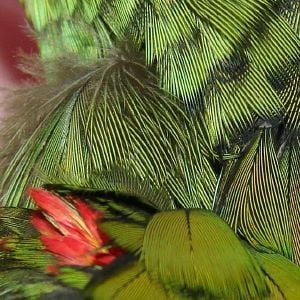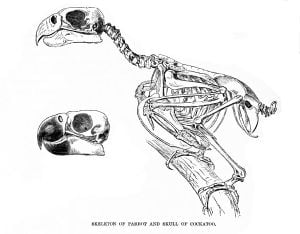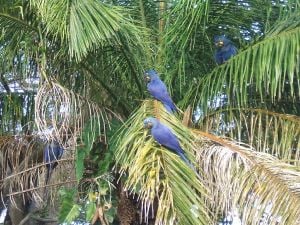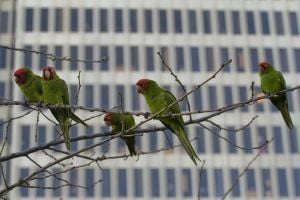Parrot
| Parrots
| ||||||||||
|---|---|---|---|---|---|---|---|---|---|---|
 Peach-fronted parakeets (Aratinga aurea)
on a termite mound in Brazil | ||||||||||
| Scientific classification | ||||||||||
| ||||||||||
|
(but see below)
Family Psittacidae (true parrots)
Family Cacatuidae (cockatoos) (paraphyletic) |
Parrot is the common name for any of the tropical and subtropical birds comprising the order Psittaciformes, characterized by large heads, upright stance, strong and clawed zygodactyl feet (two toes in front and two in back), and strong and curved beaks with the prominent, downward curving upper beak overlapping the shorter lower beak when closed. Also known as psittacines, parrots usually are grouped into two families: the Psittacidae (true parrots) and the Cacatuidae (cockatoos). Cockatoo species have a mobile crest of feathers on the top of their heads.
There are roughly 350 species in 85 genera making up the order. These include such well-known groups as macaws, parakeets, lovebirds, budgerigars, lories, and cockatoos. Parrots have a pan-tropical distribution with several species inhabiting the temperate Southern Hemisphere as well; the greatest diversity is in South America and Australia. Almost all parrots nest in tree holes (or nestboxes in captivity), and lay white eggs from which emerge altricial (helpless) young.
Many parrots are brightly colored. This quality, along with the fact that many are considered to be intelligent birds, including many species that exhibit an ability to imitate human voices, has enhanced their popularity as pets. In nature, they are important in food chains, generally consuming plant material such as seeds, nuts, fruits, and buds, and being preyed upon by birds of prey, such as hawks, and any mammals that can capture them. Some parrots also eat insects and small animals, and the lories and lorikeets are specialized to feed on nectar from flowers, and soft fruits.
Trapping of wild parrots for the pet trade, as well as other hunting, habitat loss, and competition from invasive species, have diminished wild populations. Recent conservation efforts have helped in their protection, although over 100 species are listed as near threatened or worse by the IUCN.
Description
The most obvious physical feature that characterizes parrots is their strong, curved, broad bill. The upper mandible is prominent, curves downward, and comes to a point. It is not fused to the skull, which allows it to move independently, and contributes to the tremendous biting pressure these birds are able to exert. The lower mandible is shorter, with a sharp, upward facing cutting edge, which moves against the flat portion of the upper mandible in an anvil-like fashion. Seed eating parrots have a strong tongue, which helps to manipulate seeds or position nuts in the bill so that the mandibles can apply an appropriate cracking force.
The parrot head is large, with eyes positioned sideways, which limits binocular vision, but greatly enhances peripheral vision. They have an upright stance, strong legs, and clawed feet, with two toes facing forward and two toes facing rearward on each foot, (zygodactyl).
The cockatoos (family Cacatuidae) differ from the true parrots of family Psittacidae in having a movable head crest, as well as a different arrangement of the carotid arteries, various differences in the skull bones, and having a gall bladder. Cockatoos also lack the Dyck texture feathers which, in the Psittacidae, scatters light in such a way as to produce the vibrant colors of so many parrots. The mobile crest of feathers on the top of the heads of cockatoos can be raised for display, and retracted.
Most parrots are predominantly green, with other bright colors, and some species are multicolored. Cockatoo species range from mostly white to mostly black.
Extant species range in size from the buff-faced pygmy-parrot, at under 10 grams (0.35 ounces) in weight and 8 centimeters (3.2 inches) in length, to the hyacinth macaw, at 1.0 meter (3.3 feet) in length, and the kakapo, at 4.0 kilograms (8.8 pounds) in weight. They are the most variably sized bird order in terms of length. Most parrots are monomorphic or minimally sexually dimorphic.
Range and distribution
Parrots are found on all tropical and subtropical continents including Australia and the islands of the Pacific Ocean, India, southeast Asia, southern regions of North America, South America and Africa. Some Caribbean and Pacific islands are home to endemic species. By far, the greatest number of parrot species come from Australasia and South America.
The lories and lorikeets range from Sulawesi and the Philippines in the north to Australia and across the Pacific as far as French Polynesia, with the greatest diversity being found in and around New Guinea. The subfamily Arinae encompasses all the Neotropical parrots, including the Amazons, macaws, and conures, and range from northern Mexico and the Bahamas to Tierra del Fuego in the southern tip of South America. The pygmy parrots, subfamily Micropsittinae, are a small genus restricted to New Guinea. The subfamily Nestorinae are three species of aberrant parrots from New Zealand. The broad-tailed parrots, subfamily Platycercinae, are restricted to Australia, New Zealand. and Pacific islands as far as Fiji. The final true parrot subfamily, Psittacinae, includes a range of species from Australia and New Guinea to the species found in South Asia and Africa. The center of cockatoo biodiversity is Australia and New Guinea, although some species reach the Solomon Islands (and one species formerly occurred in New Caledonia) (Steadman 2006), Indonesia, and the Philippines.
Several parrot species enter the cool, temperate regions of South America and New Zealand. One species, the Carolina parakeet, existed in temperate North America, but was hunted to extinction in the early 20th century. Numerous species have been introduced in areas with temperate climates, and have established stable populations. The monk parakeet currently breeds in at least 15 states of the United States.
While a few parrot species are wholly sedentary or fully migratory, the majority fall somewhere between the two, making poorly understood regional movements, some species adopting an entirely nomadic lifestyle.
Behavior
There are numerous difficulties in studying wild parrots, as they are difficult to catch and once caught they are difficult to mark. Most wild bird studies rely on rings (or bands) or some form of wing tag, but parrots will chew them off (Collar 1997). The parrots also tend to range widely and as a consequence there are many gaps in science's knowledge of their behavior.
Parrots have a strong, direct flight. Most species spend most of their time perched or climbing in tree canopies. They often use their bills for climbing by gripping or hooking on branches and other supports. On the ground, parrots often walk with a rolling gait.
Diet
The diet of parrots consists of seeds, fruit, nectar, pollen, buds, and sometimes insects, and to a lesser degree animal prey.
Without question the most important of these to most true parrots and cockatoos are seeds. The large and powerful bill is an adaptation to opening and consuming seeds. All true parrots except the Pesquet's parrot employ the same method to obtain the seed from the husk; the seed is held between the mandibles and the lower mandible crushes the husk, whereupon the seed is rotated in the bill and the remaining husk is removed (Collar 1997). A foot is sometimes used in order to help holding large seeds in place.

Parrots are seed predators rather than seed dispersers. Indeed, in many cases where species are recorded as consuming fruit they are only eating the fruit in order to get at the seed, and thus not dispersing the seeds for the plants reproduction but consuming the seed. As seeds often have poisons to protect them, parrots are careful to remove seed coats and other fruit parts which are chemically well defended, prior to ingestion. Many species in the Americas, Africa, and Papua New Guinea consume clay, which both releases minerals and absorbs toxic compounds from the gut (Diamond 1999).
The lories and lorikeets, swift parrot, and Philippine hanging parrot are primarily nectar and pollen consumers, and have tongues with brush tips to collect this source of food, as well as some specialized gut adaptations to accommodate this diet (Gartrell et al. 2000). Many other species also consume nectar as well when it becomes available.
In addition to feeding on seeds and flowers, some parrot species will prey on animals. Golden-winged parakeets prey on water snails, and famously the keas of New Zealand will scavenge on sheep carcasses and even kill juvenile petrels. Another New Zealand parrot, the Antipodes Island parakeet, enters the burrows of nesting gray-backed storm-petrels and kills the incubating adults (Greene 1999). Some cockatoos and the Kākā will also excavate branches and wood in order to obtain grubs.
Breeding
Although there are a few exceptions, parrots are monogamous breeders which nest in cavities and hold no territories other than their nesting sites (Collar 1997; Rowley 1997). The pair bonds of the parrots and cockatoos are strong and the pair will remain close even during the non-breeding season, even if they join larger flocks. As with many birds, pair bond formation is preceded by courtship displays; these are relatively simple in the case of cockatoos. Allopreening is used by the pair to help maintain the bond.
Only the monk parakeet and five species of Agapornis lovebird build nests in trees (Eberhard 1998), and three Australian and New Zealand ground parrots nest on the ground. All other parrots and cockatoos nest in cavities, either tree hollows or cavities dug into cliffs, banks, termite nests, or the ground. The use of holes in cliffs is more common in the Americas. In most cases, both species will participate in the nest excavation. The length of the burrow varies with species, but is usually between 0.5-2 meters in length. The nests of cockatoos are often lined with sticks, wood chips, and other plant material. In the larger species of parrot and cockatoo the availability of nesting holes can be limited and this can lead to intense competition for them. Some species are colonial, with the burrowing parrot nesting in colonies up to 70,000 strong (Masello et al. 2006).
The eggs of parrots are white. In most species, the female undertakes all the incubation, although incubation is shared in cockatoos, the blue lorikeet, and the vernal hanging parrot. The female remains in the nest for almost all of the incubation period and is fed both by the male and during short breaks. Incubation varies from 17 to 35 days, with the larger species having the longer incubation periods.
The newly-born young are altricial, either lacking feathers or with sparse white down. The young spend anything from three weeks to four months in the nest, depending on species, and may receive parental care for up to further months thereafter (Forshaw 1991).
As typical of K-selected species, the macaws and other larger parrot species have low reproductive rates. They require several years to reach maturity, produce one or very few young per year, and sometimes do not breed every year at all.
Intelligence and learning
Studies with captive birds have given us insight into which birds are the most intelligent. Along with crows, ravens, and jays (family Corvidae), parrots are considered the most intelligent of birds. While parrots have the distinction of being able to mimic human speech, studies with the African gray parrot have shown that some are able to associate words with their meanings and form simple sentences. Not only have parrots demonstrated intelligence through scientific testing of their language using ability, but some species of parrot, such as the kea, are also highly skilled at using tools and solving puzzles (Beynon 2000).
The brain-to body size ratio of psittacines and corvines is actually comparable to that of higher primates (Iwaniuk 2004). One argument against the supposed intelligent capabilities of bird species is that birds have a relatively small cerebral cortex, which is the part of the brain considered to be the main area of intelligence in other animals. However, it seems that birds use a different part of their brain, the medio-rostral neostriatum/hyperstriatum ventrale, as the seat of their intelligence. Not surprisingly, research has shown that these species tend to have the largest hyperstriata, and it has been discovered that the lower part of avian brains are functionally similar to ours.
Learning in early life is apparently important to all parrots, and much of that learning is social learning. Social interactions are often practiced with siblings, and in several species creches are formed with several broods, and these as well are important for learning social skills. Foraging behavior is generally learned from parents, and can be a very protracted affair. Supra-generalists and specialists are generally independent of their parents much quicker than partly specialized species, which may have to learn skills over a long period of time as various resources become seasonally available. Play forms a large part of learning in parrots, it can be solitary, and related to motor skills, or social. Species may engage in play fights or wild flights to practice predator evasion. An absence of stimuli can retard the development of young birds, as demonstrated by a group of vasa parrots kept in tiny cages with domesticated chickens from the age of three months; at nine months these birds still behaved in the same way as three-month-olds, but had adopted some chicken behavior (Collar 1997). In a similar fashion. captive birds in zoo collections or pets can, if deprived of stimuli, develop stereotyped behaviors and harmful behaviors like self plucking. Aviculturists working with parrots have identified the need for environmental enrichment to keep parrots stimulated.
Sound imitation and speech
File:Amazon edited.ogg Many species of parrots can imitate human speech or other sounds, and the results of a study by Irene Pepperberg suggested a high learning ability in an African gray parrot named Alex. Alex was trained to use words to identify objects, describe them, count them, and even answer complex questions such as "How many red squares?" with over 80 percent accuracy. A second example is that of N'kisi, another African gray, which has been shown to have a vocabulary of approximately a thousand words and has displayed an ability to invent as well as use words in context and in the correct tense. Michael Dalton (2007, 2009) used "passive speech research" to study a blue-and-gold macaw named Arielle and reported a wide range of verbal capabilities, including the ability to use words in the correct context and communicate with creative expressions. Details on the studies on Arielle can be found in the macaw article under "Speech and language learning."
Parrots do not have vocal cords, so sound is accomplished by expelling air across the mouth of the bifurcated trachea. Different sounds are produced by changing the depth and shape of trachea. So, talking parrots are really whistling in different variations. Congo African gray parrots (CAG) are well known for their ability to "talk," which may be caused by more control, or stronger trachea.
This ability of parrots has made them prized as pets from ancient time to now. In the Masnavi, a writing by Rumi of Persia, 1250 C.E., the author talks about an ancient method for training parrots to speak.
"Parrots are taught to speak without understanding the words. The method is to place a mirror between the parrot and the trainer. The trainer, hidden by the mirror, utters the words, and the parrot, seeing his own reflection in the mirror, fancies another parrot is speaking, and imitates all that is said by the trainer behind the mirror."
Evolution and systematics
Origins and evolution
The diversity of Psittaciformes in South America and Australasia suggests that the order has a Gondwanan origin. The parrot family's fossil record, however, is sparse and their origin remains a matter of informed speculation rather than fact.
A single 15 millimeter fragment from a lower bill (UCMP 143274), found in Lance Creek Formation deposits of Niobrara County, Wyoming, has been suggested as the first parrot fossil (Stidham 1998). Of Late Cretaceous age, it is about 70 million years old. But subsequent reviews (Dyke 1999; Waterhouse 2006) have maintained that this fossil is almost certainly not from a bird, but from a caenagnathid theropod—a non-avian dinosaur with a birdlike beak.
It is now generally assumed that the Psittaciformes or their common ancestors with a number of related bird orders were present somewhere in the world around the Cretaceous–Tertiary extinction event, some 65 mya (million years ago). If so, they may not have had yet the morphological autapomorphies characteristic of parrots, but were generalized arboreal birds, roughly similar (though not necessarily closely related) to today's potoos or frogmouths.
Europe is the site of the first generally accepted parrot fossils. The first is a wingbone of Mopsitta tanta, uncovered in Denmark and dated to 54 mya (million years ago) (Waterhouse et al. 2008). The climate at this time was tropical, consistent with the Paleocene-Eocene Thermal Maximum.
Later fossils date from the Eocene, starting around 50 mya. Several fairly complete skeletons of parrot-like birds have been found in England and Germany (Dyke and Cooper 2000). Some uncertainty remains, but on the whole it seems more likely that these are not direct ancestors of the modern parrots, but related lineages that evolved in the Northern Hemisphere but have since died out. These are probably not "missing links" between ancestral and modern parrots, but rather psittaciform lineages that evolved parallel to true parrots and cockatoos and had their own peculiar autapomorphies:
- Psittacopes (Early/Middle Eocene of Geiseltal, Germany)—basal?
- Serudaptus - pseudasturid or psittacid?
- Pseudasturidae (Halcyornithidae may be correct name)
- Pseudasturides - formerly Pseudastur
- Quercypsittidae
- Quercypsitta (Late Eocene)
The earliest records of modern parrots date to about 23 to 20 mya and are also from Europe. Subsequently, the fossil record—again, mainly from Europe—consists of bones clearly recognizable as belonging to parrots of modern type. The Southern Hemisphere does not have nearly as rich a fossil record for the period of interest as the Northern, and contains no known parrot-like remains earlier than the early to middle Miocene, around 20 mya. At this point, however, is found the first unambiguous parrot fossil (as opposed to a parrot-like one), an upper jaw that is indistinguishable from that of modern cockatoos. A few modern genera are tentatively dated to a Miocene origin, but their unequivocal record stretches back only some 5 million years.
The named fossil genera of parrots are probably all in the Psittacidae or close to its ancestry:
- Archaeopsittacus (Late Oligocene/Early Miocene)
- Xenopsitta (Early Miocene of Czechia)
- Psittacidae gen. et spp. indet. (Bathans Early/Middle Miocene of Otago, New Zealand) - several species
- Bavaripsitta (Middle Miocene of Steinberg, Germany)
- Psittacidae gen. et sp. indet. (Middle Miocene of France) - erroneously placed in Pararallus dispar, includes "Psittacus" lartetianus
Some Paleogene fossils are not unequivocally accepted to be of psittaciforms:
- Palaeopsittacus (Early - Middle Eocene of NW Europe) - caprimulgiform (podargid?) or quercypsittid?
- "Precursor" (Early Eocene) - part of this apparent chimera seems to be of a pseudasturid or psittacid
- Pulchrapollia (Early Eocene)—includes "Primobucco" olsoni - psittaciform (pseudasturid or psittacid)?
Phylogeny
The phylogeny of the parrots is still under investigation. The classifications as presented reflect the current status, which is disputed and therefore subject to change when new studies resolve some of the open questions. For that reason, this classification should be treated as preliminary.
The Psittaciformes are generally considered to consist of two major living lineages of family rank: the true parrots (Psittacidae) and the cockatoos (Cacatuidae).
The Cacatuidae are quite distinct, having a movable head crest, a different arrangement of the carotid arteries, a gall bladder, differences in the skull bones, and lack the Dyck texture feathers which, in the Psittacidae, scatters light in such a way as to produce the vibrant colors of so many parrots. However, the actual situation may be more complex.
While understanding of the relationships between subgroups of true parrots—for example, the one containing the gray parrot versus the relatives of the Budgerigar—are rather well resolved and knowledge of relationships between species has much improved in the last years, it is still a matter of dispute whether the distinct lineages of true parrots should be considered subfamilies or tribes. Because parrot fossils and molecular divergence date estimates provide insufficient data to properly resolve when exactly the major diversification and divergence periods in parrot evolution took place, it is difficult to determine how distinct from one another the various lineages really are, and how fast and radically they were changed by evolution.
Lorikeets were previously regarded as a third family, Loriidae (Forshaw and Cooper 1978), though now most often considered a subfamily of the Psittacidae (Forshaw and Cooper 2002). The present majority view is that they are distinct enough to warrant subfamily status, but some consider the quite pronounced differences not evidence of a uniquely deep evolutionary split but rather not different quantitatively from the differences between more closely related lineages. Biogeography suggests that the lorikeets are best considered a uniquely distinct lineage, not as divergent as cockatoos maybe, but still standing apart from other psittacids.
Recent molecular studies, such as that of mtDNA in 1998 (Miyaki et al. 1998), or the sex chromosome spindlin gene in 2005 (de Kloet and de Kloet 2005), find the relationships of the main lineages of living parrots to be for the most part unresolvable with any confidence. An unexpected result was that according to the spindlin sequence data, the only major divergence among living parrots that could be reliably positioned in the calculated phylogenies occurred between some New Zealand parrots—kakapo, kākā, and kea—and the remaining psittaciformes.
The case for distinctness of at least the nestorines seems to be fairly complete by now. Its position—with or without the kakapo—and its ancient age as suggested by the molecular data are at odds with the fossil record, however, as it would require an absurdly high degree of homoplasy and a decidedly non-parsimonious character distribution in living parrots. As the study relies upon an obsolete molecular clock model uncalibrated by material evidence, the results are highly spurious. The scenario of Miyaki et al. (1998), while less complete (and excluding the kakapo) agrees better, though not completely, with the material evidence. Again, an unreliable molecular clock model was used.
While the latter two seem indeed to constitute a distinct lineage, placement of the kakapo with these is contradicted by mtDNA cytochrome b sequence data (Miyaki et al. 1998). In any case, the major lineages of psittacines seem indeed to represent distinct clades, but their relationship among them is not well resolvable by the present molecular data. They appear to have radiated throughout a fairly limited timespan, approximately during the Eocene. One finding of major importance is that neither cockatoos nor lories seem to be as distinct from other major parrot lineages as they are usually assumed to be.
Classification
The following classification of the true parrots in family Psittacidae is a version in which several subfamilies are recognized. Molecular data (see above) suggests that several subfamilies might indeed be valid and perhaps even be elevated to family rank, but the arrangement of tribes in these is not well resolved at present.
Family Psittacidae: true parrots
- Subfamily Arinae: Neotropical parrots, about 160 species in some 30 genera. Probably 2 distinct lineages (Miyaki et al. 1998; de Kloet and de Kloet 2005)
- Subfamily Loriinae: Around a dozen genera with some 50 species of lorikeets and lories, centered in New Guinea, spreading to Australia, Indonesia, and the islands of the south Pacific.
- Subfamily Micropsittinae: 6 species of pygmy parrot, all in a single genus.
- Subfamily Nestorinae or Strigopinae: The New Zealand parrots.
- Tribe Nestorini: 1 genus with only 2 living species, the Kea and Kākā of the New Zealand region.
- Tribe Strigopini: The flightless, nearly extinct Kakapo of New Zealand.
- Subfamily Psittacinae
- Tribe Cyclopsitticini: fig parrots, 3 genera, all from New Guinea or nearby.
- Tribe Polytelini: three genera from Australia and the Wallacea. - may belong to broad-tailed parrots.
- Tribe Psittrichadini: A single species, Pesquet's Parrot.
- Tribe Psittacini: Afrotropical parrots, about a dozen species in 3 genera.
- Tribe Psittaculini: Paleotropic psittaculine parrots, nearly 70 living species in 12 genera, distributed from India to Australasia.
- Subfamily Platycercinae: Broad-tailed parrots; nearly 30 species in roughly one dozen genera.
- Tribe Melopsittacini: one genus with one species, the budgerigar.
- Tribe Neophemini: two small genera of parrots.
- Tribe Pezoporini: one genus of parrots with two quite distinct species.
- Tribe Platycercini: Rosellas and relatives; around 20 species in 8 genera.
Relationship with humans
Humans and parrots have a complicated relationship. Economically, parrots can be beneficial to communities as sources of income from the pet trade and are highly marketable tourism draws and symbols. But some species are also economically important pests, particularly some cockatoo species in Australia. Some parrots have also benefited from human changes to the environment in some instances, and have expanded their ranges where agricultural practices, while many parrots have declined as well.
As tens of millions of individual parrots have been removed from the wild, parrots have been traded in greater numbers and for far longer than any other group of wild animals (Snyder et al. 2000). Many parrot species are still threatened by this trade as well as habitat loss, predation by introduced species, and hunting for food or feathers. Some parrot species are agricultural pests (Warburton and Perrin 2006), eating fruits, grains, and other crops, but parrots can also benefit economies through birdwatching based ecotourism (Christian et al. 1999).
Parrots as pets

Popular as pets due to their sociable and affectionate nature, high intelligence, bright colors, and ability to imitate human voices, parrots have historically been kept as pets in many cultures. Europeans kept birds matching the description of the rose-ringed parakeet (or called the ring-necked parrot), such as in this first century account by Pliny the Elder:
"The parrot, which comes from India, is a green bird with a red circlet around its neck. It can be taught to speak; it greets its master and repeats words said to it. Its head and beak are very hard. While being taught to speak it must be beaten on the head with an iron rod; its head is so hard that it will not feel lesser blows. Its feet are weak, so when it lands from flying it does so on its beak, and supports itself thus."
As they have been prized for thousands of years for their beauty and ability to talk, they have also often been misunderstood. For example, author Wolfgang de Grahl discusses in his 1987 book The Grey Parrot that some importers allowed parrots to drink only coffee while they were being shipped by boat considering pure water to be detrimental and believing that their actions would increase survival rates during shipping. (These days it is commonly accepted that the caffeine in coffee is toxic to birds.)
Pet parrots may be kept in a cage or aviary; though generally, tame parrots should be allowed out regularly on a stand or gym. Depending on locality, parrots may be either wild caught or be captive bred, though in most areas without native parrots, pet parrots are captive bred.
Parrots species that are commonly kept as pets include conures, macaws, Amazons, cockatoos, African Grays, lovebirds, cockatiels, budgerigars, eclectus, Caiques, parakeets, Pionus, and Poicephalus. The domesticated Budgerigar, a small parrot, is the most popular of all pet bird species. Species vary in their temperament, noise level, talking ability, cuddliness with people, and care needs, although how a parrot has been raised usually greatly affects its personality.
Parrots are popular as pets due to their beauty, intelligence, and sociable natures. Parrots can make excellent companion animals, and can form close, affectionate bonds with their owners. Parrots that are bred for pets may be handled or otherwise accustomed to interacting with people from a young age to help ensure they will be tame and trusting. However, parrots are not low maintenance pets; they require feeding, grooming, veterinary care, training, environmental enrichment through the provision of toys, exercise, and social interaction (with other parrots or humans) for good health. Some large parrot species, including large cockatoos, Amazons, and macaws, have very long lifespans with 80 years being reported and record ages of over one hundred. Small parrots, such as lovebirds, hanging parrots, and budgies have shorter life spans of up to 15-20 years. Some parrot species can be quite loud, and most larger parrots can be destructive and require a very large cage, and a regular supply of new toys, branches, or other items to chew up.
The popularity, longevity, and intelligence of many of the larger pet parrots has led to many of these birds being rehomed during the course of their long lifespans. A common problem is that large parrot species that are cuddly and gentle as juveniles will mature into complex, often demanding adults that can outlive their owners. Due to these problems, and the fact that homeless parrots are not euthanized like dogs and cats, parrot adoption centers and sanctuaries are becoming more common.
Trade of parrots
The popularity of parrots as pets has led to a thriving, and often illegal, trade in the birds, and some species are now threatened with extinction. A combination of trapping of wild birds and damage to parrot habitats makes survival difficult or even impossible for some species of parrot. Importation of wild caught parrots into the United States and Europe is illegal, but continue to be smuggled into the countries as the birds can command a high price.
Different nations have different methods of handling internal and international trade. Australia has banned the export of its native birds since 1960. The United States protects its only native parrot through its Endangered Species Act, and protects other nations' birds through its Wild Bird Conservation Act. Following years of campaigning by hundreds of NGOs and outbreaks of avian flu, in July 2007, the European Union halted the importation of all wild birds with a permanent ban on their import. Prior to an earlier temporary ban started in late October 2005, the EU was importing approximately two million live birds a year, about 90 percent of the international market: hundreds of thousands of these were parrots. There are no national laws protecting feral parrot populations in the USA. Mexico has a licensing system for capturing and selling native birds (though the laws are not well enforced).
Parrots and culture
Parrots have featured in human writings, story, art, humor, religion, and music for thousands of years (Boehrer 2004).
In ancient times and currently parrot feathers have been used in ceremonies, and for decoration. The "idea" of the parrot has been used to represent the human condition in medieval literature such as the bestiary. They also have a long history as pets.
In Polynesian legend as current in the Marquesas Islands, the hero Laka/Aka is mentioned as having undertaken a long and dangerous voyage to Aotona in what are now the Cook Islands, in order to obtain the highly prized feathers of a red parrot as gifts for his son and daughter. On the voyage a hundred out of his 140 rowers died of hunger on their way, but the survivors reached Aotona and captured enough parrots to fill 140 bags with their feathers (Craig 1989). By at least some versions, the feathers were plucked off living parrots without killing them.
Parrots have also been considered sacred. The Moche people of ancient Peru worshipped birds and often depicted parrots in their art (Berrin and Larco 1997).
Sayings about parrots color the modern English language. The verb "parroting" can be found in the dictionary, and means "to repeat by rote."
Feral populations
Escaped parrots of several species have become established in the wild outside their natural ranges and in some cases outside the natural range of parrots. Among the earliest instances were pet red shining-parrots from Fiji, which established a population on the islands of southern Tonga. These introductions were prehistoric and red-shining parrots were recorded in Tonga by Captain Cook in the 1770s (Steadman 2006). Escapees first began breeding in cities in California, Texas, and Florida in the 1950s (with unproven earlier claims dating back to the 1920s in Texas and Florida) (Butler 2005). They have proved surprisingly hardy in adapting to conditions in Europe and North America. They sometimes even multiply to the point of becoming a nuisance or pest, and a threat to local ecosystems, and control measures have been used on some feral populations (DOC 2008).
Threats and conservation
A large number of parrot species are in decline, and several species have become extinct. Of the 350 or so living species of parrot, 130 species are listed as near threatened or worse by the IUCN (2006). Parrots have been subjected to more exploitation than any other group of birds (Snyder et al. 2000). Recent conservation measures to conserve the habitats of some of the high-profile charismatic parrot species has also protected many of the less charismatic species living in the ecosystem (Snyder et al. 2000).
There are numerous reasons for the decline of so many species, the principal threats being habitat loss, hunting, and for some species, wild-bird trade. Parrots are persecuted for a number of reasons; in some areas they may (or have been) hunted for food, for feathers, and as agricultural pests. For a time, Argentina offered a bounty on monk parakeets (an agricultural pest), resulting in hundreds of thousands of birds being killed, though apparently this did not greatly affect the overall population (Campbell 2000). Capture for the pet trade is a threat to many of the rarer or slower to breed species. Habitat loss or degradation, most often for agriculture, is a threat to numerous parrot species. Parrots, being cavity nesters, are vulnerable to the loss of nesting sites and to competition with introduced species for those sites. The loss of old trees is particularly a problem in some areas, particularly in Australia where suitable nesting trees may be many hundreds of years old. Many parrot species occur only on islands and are vulnerable to introduced species such as rats and cats, as they lack the appropriate anti-predator behaviors needed to deal with mammalian predators. Controlling such predators can help in maintaining or increasing the numbers of endangered species (Moorhouse et al. 2002). Insular species, which have small populations in restricted habitat, are also vulnerable to physical threats such as hurricanes and volcanic eruptions.
At present the IUCN recognizes 19 species of parrot as extinct since 1600 (the date used to denote modern extinctions) (IUCN 2007). This does not include species like the New Caledonian lorikeet which has not been officially seen for 100 years yet is still listed as critically endangered.
Trade, export, and import of all wild-caught parrots is regulated and only permitted under special licensed circumstances in countries party to CITES, the Convention on the International Trade in Endangered Species, that came into force in 1975 to regulate the international trade of all endangered wild caught animal and plant species. In 1975, 24 parrot species were included on Appendix I of CITES, thus prohibiting commercial international trade in these birds. Since that initial listing, continued threats from international trade have lead CITES to add an additional 32 parrot varieties to Appendix I (ABC et al. 2005). All the other parrot species are protected on Appendix II of CITES. In addition, individual countries may have laws to regulate trade in certain species.
ReferencesISBN links support NWE through referral fees
- American Bird Conservancy (ABC), Defenders of Wildlife, Eurogroup for Animal Welfare, et al. 2005. The European Union Wild Bird Declaration: An NGO call to halt wild bird imports into the European Union. Birdsareforwatching.org. Retrieved November 6, 2008.
- American Heritage Dictionary of the English Language, 4th edition. psittacine. Houghton Mifflin. Retrieved November 6, 2008.
- Berrin, K., and Larco Museum. 1997. The Spirit of Ancient Peru: Treasures from the Museo Arqueológico Rafael Larco Herrera. New York: Thames and Hudson. ISBN 0500018022.
- Beynon, M. 2000. Who's a clever bird, then? BBC News April 2000.
- BirdLife International. 2008. Species factsheet: Anodorhynchus hyacinthinus. 2006 IUCN Red List of Threatened Species. IUCN 2006.
- Boehrer, B. 2004. Parrot Culture: Our 2,500-year-long Fascination With the World's Most Talkative Bird. Philadelphia: University of Pennsylvania Press. ISBN 9780812237931.
- Butler, C. 2005. Feral parrots in the continental United States and United Kingdom: Past, Present, and Future. Journal of Avian Medicine and Surgery 19(2): 142-149.
- Campbell, T. S. 2000. The monk parakeet. The Institute for Biological Invasions.
- Christian, C., T. Potts, G. Burnett, and T. Lacher. 1999. Parrot conservation and ecotourism in the windward islands. Journal of Biogeography 23(3): 387-393.
- Collar, N. 1997. Family Psittacidae (parrots). In J. del Hoyo and L. F. Baptista, eds., Handbook of the Birds of the World: Volume 4, Sandgrouse to Cuckoos. Barcelona: Lynx. ISBN 8487334229.
- Craig, R. D. 1989. Dictionary of Polynesian Mythology. New York: Greenwood. ISBN 0313258902.
- Dalton, M. S. 2007. Another Kind of Mind: A Talking Bird Masters English (Clearwater, FL: Arielle Publishing). ISBN 0979969808.
- Dalton, M. S. 2009. Passive speech research, language, and the animal mind. 2009 Proceedings of the 35th Annual Convention of The American Federation of Aviculture (Houston, TX): 76-82
- de Grahl, W. 1987. The Grey Parrot. Neptune City, NJ: T.F.H. Publications. ISBN 0866224955.
- de Kloet, R. S., and S. R. de Kloet. 2005. The evolution of the spindlin gene in birds: Sequence analysis of an intron of the spindlin W and Z gene reveals four major divisions of the Psittaciformes. Molecular Phylogenetics and Evolution 36: 706-721.
- Department of Conservation (DOC). 2008. DOC's work with rainbow lorikeet. Department of Conservation, New Zealand. Retrieved November 6, 2008.
- Diamond, J. 1999. Evolutionary biology: Dirty eating for healthy living. Nature 400(6740): 120-121.
- Dyke, G. J., and G. Mayr. 1999. Did parrots exist in the Cretaceous period? Nature 399: 317-318
- Dyke, G. J., and J. H. Cooper. 2000. A new psittaciform bird from the London clay (Lower Eocene) of England. Palaeontology 43: 271-285.
- Eberhard, J. 1998. Evolution of nest-builing behavior in Agapornis parrots. Auk 115(2): 455-464.
- Forshaw, J. 1991. Encyclopaedia of Animals: Birds. London: Merehurst. ISBN 1853911860.
- Forshaw, J. M., and W. T. Cooper. 1978. Parrots of the World, 2nd ed. Melbourne, Australia: Landsdowne Editions. ISBN 0701806907.
- Forshaw, J. M., and W. T. Cooper. 2002. Australian Parrots, 3rd ed. Robina, Qld.: Alexander Editions. ISBN 0958121206.
- Gartrell, B., S. Jones, R. Brereton., and L. Astheimer. 2000. Morphological adaptations to nectarivory of the alimentary tract of the swift parrot Lathamus discolor. Emu 100(4) 274-279.
- Greene, T. 1999. Aspects of the ecology of Antipodes Island parakeet (Cyanoramphus unicolor) and Reischek's parakeet (C. novaezelandiae hochstetten) on Antipodes Island. Notornis 46(2): 301–310. Retrieved November 6, 2008.
- Handy, E. S. C. 1930. Marquesan Legends. Honolulu: Bernice P. Bishop Museum.
- International Union for Conservation of Nature and Natural Resources (IUCN). 2006. IUCN Red List of Threatened Species. Gland, Switzerland: IUNC.
- Iwaniuk, A. 2004. This bird is no airhead. Natural Sciences and Engineering Research Council of Canada. Retrieved November 6, 2008.
- Masello, J. M. Pagnossin, C. Sommer, and P. Quillfeldt. 2006. Population size, provisioning frequency, flock size and foraging range at the largest known colony of Psittaciformes: The burrowing parrots of the north-eastern Patagonian coastal cliffs. Emu 106(1): 69-79.
- Miyaki, Y., R. Matioli, T. Burke, and A. Wajntal. 1998. Parrot evolution and paleogeographical events: Mitochondrial DNA evidence. Molecular Biology and Evolution 15(5): 544–551. Retrieved November 6, 2008.
- Moorhouse, R., T. Greene, P. Dilks, R. Powlesland, L. Moran, G. Taylor, A. Jones, J. Knegtmans, D. Wills, M. Pryde, I. Fraser, A. August, and C. August. 2002. Control of introduced mammalian predators improves kaka Nestor meridionalis breeding success: Reversing the decline of a threatened New Zealand parrot. Biological Conservation 110(1): 33-44.
- Pliny the Elder. (1st century C.E.) Parrot. Natural History Book 10, 58.
- Rowley, I. 1997. Family Cacatuidae (Cockatoos). In J. del Hoyo and L. F. Baptista, eds., Handbook of the Birds of the World: Volume 4, Sandgrouse to Cuckoos. Barcelona: Lynx. ISBN 8487334229.
- Snyder, N., P. McGowan, and A. Grajal. (Eds.) 2000. [http://www.parrots.org/index.php/ourpublication/papfiles/ Parrots. Status Survey and Conservation Plan 2000-2004. Gland, Switzerland: IUCN. Retrieved November 6, 2008.
- Steadman, D. 2006. Extinction and Biogeography in Tropical Pacific Birds. University of Chicago Press. ISBN 9780226771427.
- Stidham, T. 1998. A lower jaw from a Cretaceous parrot. Nature 396: 29-30.
- Warburton, L. S., M. R. Perrin. 2006. The Black-cheeked lovebird (Agapornis nigrigenis) as an agricultural pest in Zambia. Emu 106(4): 321-328.
- Waterhouse, D. M. 2006. Parrots in a nutshell: The fossil record of Psittaciformes (Aves). Historical Biology 18(2): 227-238.
- Waterhouse, D. M., B. E. K. Lindow, N. Zelenkov, and G. J. Dyke. 2008. Two new fossil parrots (Psittaciformes) from the Lower Eocene Fur Formation of Denmark. Palaeontology 51: 575-582.
| ||||||||||||||||||||||||||
Credits
New World Encyclopedia writers and editors rewrote and completed the Wikipedia article in accordance with New World Encyclopedia standards. This article abides by terms of the Creative Commons CC-by-sa 3.0 License (CC-by-sa), which may be used and disseminated with proper attribution. Credit is due under the terms of this license that can reference both the New World Encyclopedia contributors and the selfless volunteer contributors of the Wikimedia Foundation. To cite this article click here for a list of acceptable citing formats.The history of earlier contributions by wikipedians is accessible to researchers here:
The history of this article since it was imported to New World Encyclopedia:
Note: Some restrictions may apply to use of individual images which are separately licensed.
